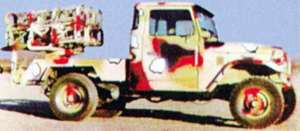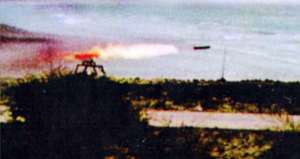| Designation: | Falaq-1 |
 |
|---|---|---|
| Manufacturer: | Aerospace Industries Organisation (AIO) | |
| Product type: | Weapons & Weapon Systems | |
| Name: | Multiple rocket launcher |
It is understood that this system was developed in the 1990s by the Shahid Bagheri Industries, which is part of the Aerospace Industries Organisation.
The 240 mm unguided surface-to-surface rocket is very similar to the rocket used with the Russian 240 mm (12-round) BM-24 system based on a ZIL-157 (6 × 6) truck chassis. This was first fielded by the Russian Army in the 1950s but has long since been replaced in service by more modern systems.
The Russian 240 mm (12-round) BM-24 system is understood to have been deployed by a number of other countries including Algeria, Egypt, former East Germany, Israel, North Korea, Poland and Syria. Production of the BM-24 was completed some time ago and it has been phased out of service with the Russia Army.
The Russian BM-24 fired two types of 240 mm unguided surface-to-surface rockets. The so called long rocket had a length of 1.29 m, weighed 109 kg and had a maximum range of 10,200 m. The so called short rocket had a length of 1.225 m, weighed 112 kg and had a maximum range of 6,575 m.
Israel captured a number of the BM-24 systems and these entered service with the Israel Defence Force (IDF) with Israel Military Industries manufacturing the rockets. It is understood that these systems have now been phased out of front line service with the IDF but these systems may well be held in reserve.
The only known 240 mm system fielded to date by Iran is based on a 4 × 4 jeep light cross-country vehicle with the engine at the front and two door fully enclosed cab in the centre.
Mounted on the rear of the chassis is what appears to be a six-round frame-type launcher with two layers each of three for the 240 mm rockets. Before the rockets are launched, two stabilisers are manually lowered to the ground, one at each side at the rear of the vehicle. These stabilisers provide stability to the platform when the rockets are launched. Once fired the launcher would rapidly be moved to a concealed area where it would be reloaded manually.
As a cab is not fitted with blast protection shutters, its is considered that the launcher is traversed left or right prior to rockets being launched.
The 240 mm spin stabilised rockets have a maximum range of 10,000 m and are fitted with a nose-mounted fuze. Propellant used is of the solid double-base type.
The same chassis is used as the launch platform for the Iranian Falaq-2, which has a single tube-type launcher mounted on the rear. This launches a single 333 mm unguided surface-to-surface rocket to a maximum range of 10,800 m.
|
||||||
 |
 |